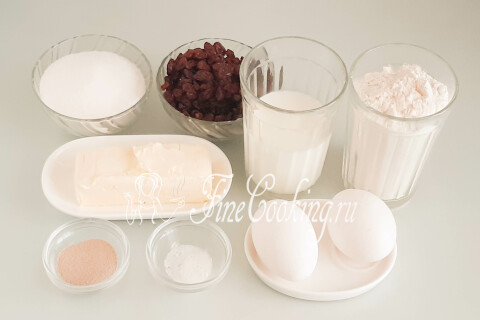Step 1
To prepare traditional Easter cakes, we will need the following ingredients: wheat flour of the highest grade, milk, butter, chicken eggs, sugar, raisins without bones, high -speed yeast and salt.
Step 2
You can knead the oily yeast dough with both hands and with the help of dough (nozzle — hook). The second option is always more successful. We sift 400 grams of flour into the container for kneading (we leave 50 grams in case the dough is too wet). Add 5 grams (a teaspoon with a slide) of high -speed yeast and half a teaspoon of salt.
Step 3
Mix so that the yeast and salt are evenly distributed along the dry mixture.
Step 4
Next, pour 120 milliliters of warm (not hot!) Milk of any fat content, break a couple of large ones (I have each) chicken eggs. Add 120 grams of sugar.
Step 5
Mix the ingredients with your hand or test so that almost all the flour is moistened. After that, you can enter soft butter (100 grams) in parts (literally 1 teaspoon). Not melted, namely soft (let it lie down at room temperature for 2-3 hours).
Step 6
We knead the dough, adding more flour if necessary (perhaps 50 grams are not enough for you, since its number depends on the humidity of the product). As a result of a rather long kneading, the yeast dough should become absolutely smooth, delicate and quite a little sticky. It perfectly keeps the shape when you collect it in the ball, but at the same time retains softness. We leave the dough for future Easter cakes in warm (no more than 35 degrees) place for primary fermentation for 1 hour. So that it does not be swollen and not covered with a crust, cover the container with a damp towel or tighten with cling film.
Step 7
Meanwhile, prepare raisins (100 grams). You can buy dark or gold — how much you like. My, we throw it on a sieve and dry it on a napkin.
Step 8
After 1 hour (+_10-15 minutes), the dough should grow at least 2 times.
Step 9
Add to him raisins, which I completely forgot to fad with flour (enough 1 teaspoon). Thanks to this method, dried berries will quickly stick to the dough and will not fall out when kneading.
Step 10
We intervene raisins into the dough, round it again and give repeated fermentation for about 1 hour.
Step 11
During this time, the cakes dough should grow even more — mine has risen three times.
Step 12
Divide it into 2 identical parts and roll each into the ball.
Step 13
While the dough was wandering, we have prepared forms for future pastries. I have this special detachable forms (diameter — 13 cm, height — 11 cm), the bottom and sides of which I lined up with parchment paper.
Step 14
We put the blanks in the molds.
Step 15
We cover with cling film or bag so that the top is not covered with a crust, and leave it on the table or in a warm place until the dough grows 2.5-3 times.
Step 16
The dough is butt and he needs a decent time for proofing (it took me 70 minutes).
Step 17
We bake traditional cakes with raisins in a preheated oven to 165-170 degrees in the upper niz mode. If the hat begins to blush too actively, switch the oven only to the lower baking mode or cover the cakes with foil. Mine baked in 37 minutes.
Step 18
We take out ready -made Easter cakes from the forms and let them cool completely, after which you can decorate. One cake was slightly demolished by the roof (because the distance was not completely), but this defect is easily masked by a glaze hat.
Step 19
This year, I again prepared glaze on gelatin (I remind you, the recipe here), used confectionery sprinkling and several twigs of willow. Happy Easter, Friends! Successful Easter cakes and pleasant appetite!



















